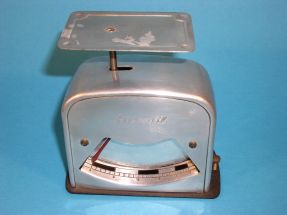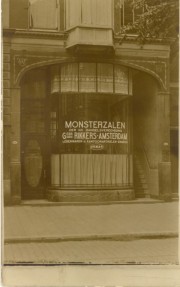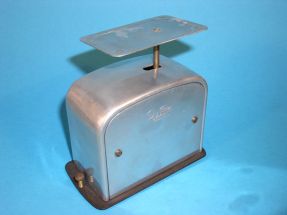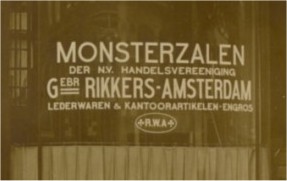Airmail
letter scale
supplier
Rikkers brothers, Amsterdam

Research on post cards done by people of the Dutch site Search pictures in old post cards showed that this shop was in Rotterdam at the Van Oldenbarneveldtstraat 99b. The property was destroyed in the beginning of World War II by the bombing in May 1940. I don't know yet when the Rikkers company started. But I have found in a book from the year 1892 that Rikkers brothers was already active in this year. The book is the catalog of the International Exhibition of Book Trade and Related Subjects in the Palace of Industry in Amsterdam, July-August 1892, organized by the Association to promote the interests of the booksellers to mark the 75th anniversary, 1817-1892. In those days Rikkers was established in the Warmoesstraat 152-154, Amsterdam. Early sixties, Rikkers was established in a large building with seven floors located on the Prinsengracht 612-622. Rikkers was then passed into Rikkers, Blazer & Metz (RBM), which was later acquired by Bührmann-Tetterode, and this was later incorporated into Esveha.
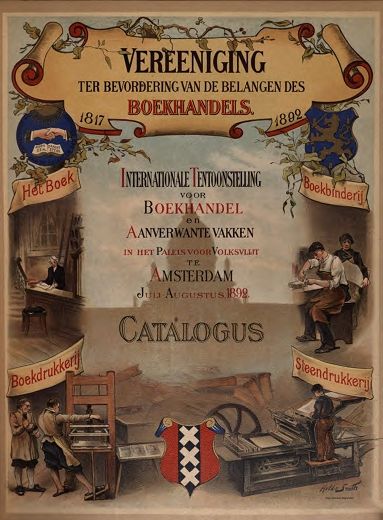
a beautiful inner page in color from the catalog of the
International Exhibition of Book Trade and Related Subjects
in the Palace of Industry in Amsterdam, July-August 1892
by the Association to promote the interests of the booksellers
organized to mark the 75th anniversary, 1817 -1892
It was made by Hobbe Smith, born December 7, 1862 in Witmarsum
in Friesland, the Netherlands, he first worked in a stone printers
in Amsterdam (Lithographer), later he became a painter,
studied at the Imperial Academy of Fine Arts in Amsterdam
and at the Drawing Academy of Antwerp.
He died in Amsterdam on March 1, 1942. |
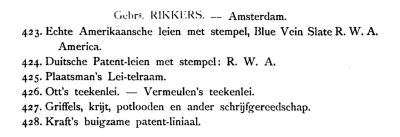
Gebr. Rikkers Amsterdam presented themselves on page 75
of the catalog of the International Exhibition of 1892
with numbered consecutively the six products exhibited by Rikkers
some with the addition R.W.A.
|
The letters R.W.A. stand on various products supplied by Rikkers.
They are also in the already mentioned 1892 catalog. In an ad for "pencils" of Rikkers in the newspaper 'The News of the Day' of December 20, 1911 is stated "every pencil has the name of our company or our trademark RWA. The R.W.A. acronym stands on slates of the American Blue Vein Slate Company of America, slates from Germany, the packaging of Robert chalk, on various kinds of pens, for example, the dip pens.
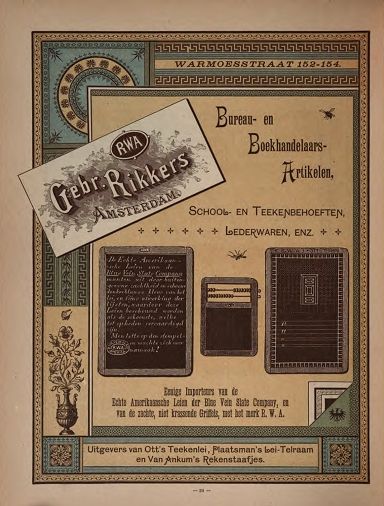
page 30 of the advertising section of the catalog
of the International Exhibition of 1892
Gebr. Rikkers Amsterdam R.W.A. present themselves being
the sole importers of Blue Vein Slate Company slates,
and as publishers of Ott's drawing slates,
Plaatsman's slate-abacus and Van Ankum's accounting rods. |
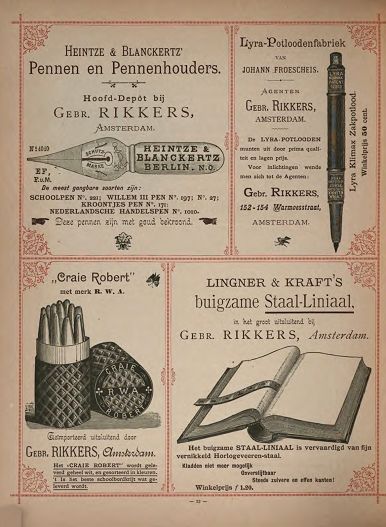
page 32 of the advertising section of the catalog of the
International Exhibition of 1892 is totally covered by
Rikkers Bros, Amsterdam. They have the main depot of
Heintze & Blankertz' pens and pen holders,
are agents of Lyra pencils by Johann Froescheis,
are the only importers of "Craie Robert" chalk and
sole importers of Lingner & Kraft's flexible steel ruler |
And the registered trademark R.W.A. is also on the back of the pictured Airmail letter scale. I still could not find the meaning of the abbreviation R.W.A.. Maybe it stands for Rikkers Waren Amsterdam (= Rikkers Goods Amsterdam), or perhaps Rikkers Warmoesstraat Amsterdam? (= Rikkers Warmoes Street, Amsterdam). The Benelux Office for Intellectual Property reported on my request to have no information about this lapsed trademark RWA. I hope that an owner of an old Rikkers catalog can provide me with a conclusive answer.
The house of the scale is very similar to the house of the Syro. The Syro-house is a one piece mold Aluminum. The Rikkers house is assembled of several plates, a front plate and back plate and a pressed part with curved shapes. Also, the arrangement of the leveling screw varies. In the Syro from the top and all through the house of the scale, At the Rikkers next to the house in the somewhat extended base plate. This Airmail letter scale has a very limited weighing range of 25 grams. The house and the top plate are of aluminum. The screws and feet are brass. The base is of magnetic steel with a black matte top coating. From a careful inspection of the bottom I discovered under the black coating an embossed name: "ENERGY" ST. OEDENRODE HOLLAND. Is this the name of the company where these scales were produced for the company Rikkers? Or was this Airmail letter scale a business present, a promotional article, of "ENERGY"?
More common letter scales with the name Rikkers do exist also, with a weighing range of 100 grams. The Rikkers RWA 100.

the first Dutch 'by Air Mail' label
(= 'per Luchtpost') from 1926 |

'by Air Mail' label Royal Mail
England | 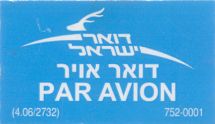
'by Air Mail' label Israel
| 
'by Air Mail' label Hong Kong
|
The first transport of mail by air in the Netherlands was done on the route London-Amsterdam on May 17, 1920. In the first flight to the Dutch Indies was on top of normal postage paid an additional air charge of NLG 2.50 for a postcard, and for other documents an additional air charge of NLG 10.00 per 20 grams. Fairly soon afterwards in 1928 the additional air charges were sharply reduced to 40 cents per postcard and for other documents to 75 cents per 20 grams. Later a cheap rate for up to 5 grams was introduced. The introduction of special lightweight airmail paper weighing 30 grams or less per square meter, also helped to reduce costs for the sender. Also aerogrammes were introduced, folded and glued in such a way that no longer a separate envelope was necessary, This also helped to keep the weight of an airmail letter low. A postal rate category for items between 5 and 10 grams existed for Air Mail between the Netherlands and the Dutch Indies.
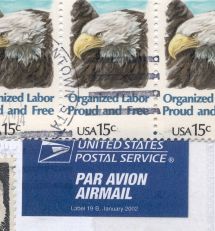
'by Air Mail' label of the American
Mail Company USPS |
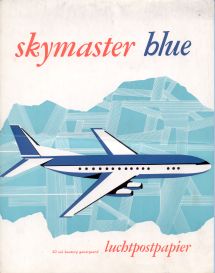
notepad airmail paper
Skymaster Blue | 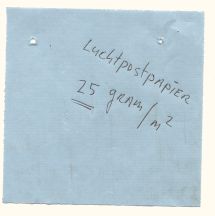
weighing result with paper scale
of a sample airmail paper:
25 grams per square meter [g/m²] | 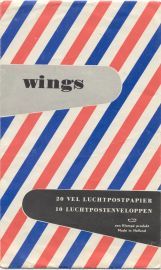
packaging airmail paper
sheets and airmail envelopes
of the brand: Wings |
Air charge to many countries located overseas were split into the category Letters and (picture)post cards and into the other items category (printed matter, legal documents, samples etc.). In the early periods an Airmail charge for letters up to 5 grams was valid. The other items category was subdivided into 0-20, 20-50 and per 50 grams more. Later the Air mail charge for picturepostcards and other items was fixed per 10 grams. This was true for newspapers and journals as well. As of June 12, 1937, the additional air charges for airmail abolished. In the Netherlands you had to write on the envelope left and above the address clearly and underlined (preferably with a colored line) the following text:
PER LUCHTPOST. In addition, the destination also had to be marked with a clear stroke (preferably by a window of colored lines). Later, in 1926 Air Mail labels were introduced, the first were yellow with black text. In 1927, these labels are legally required. In 1929 it was agreed that international airmail labels had to be blue. Because the language in the Universal Postal Union (UPU = Universal Postal Union = Union Postale Universelle) was French, there is always "Par Avion" printed on the Air Mail labels as well.
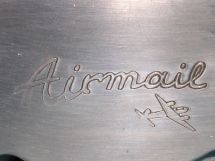
Airmail (in Dutch: luchtpost)
|
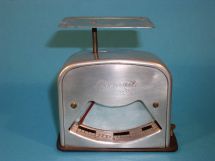
the front
| 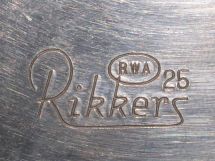
the name RIKKERS,
indication of weighing range 25
and the registered trademark R.W.A. |
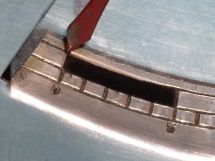
stripes of measure per gram
|
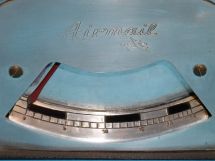
folded scale
|
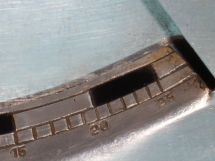
the weighing range is 25 grams
|
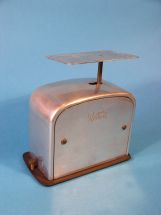
name Rikkers is at the back
|
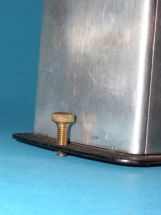
leveling screw through base
|
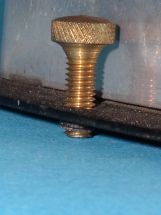
brass leveling screw
|
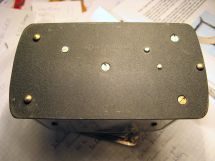
the bottom with brass screws and
two fixed and one adjustable support
|
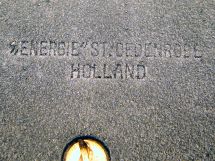
detail of the bottom with the text:
"ENERGIE" ST. OEDENRODE
HOLLAND |

